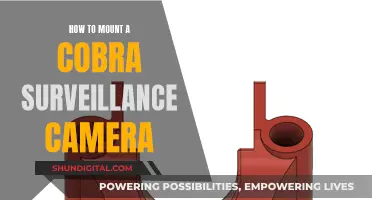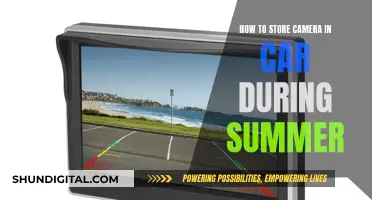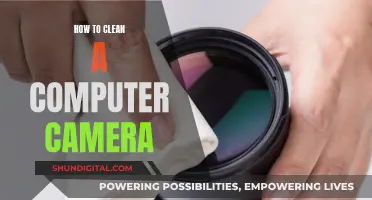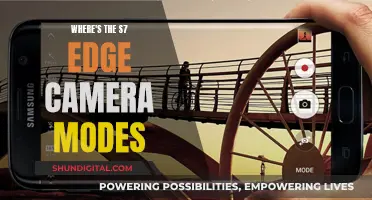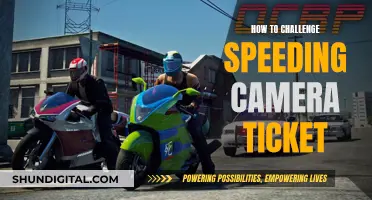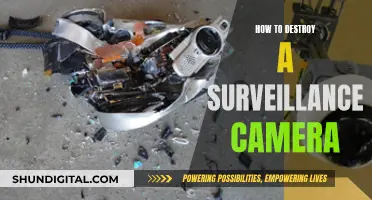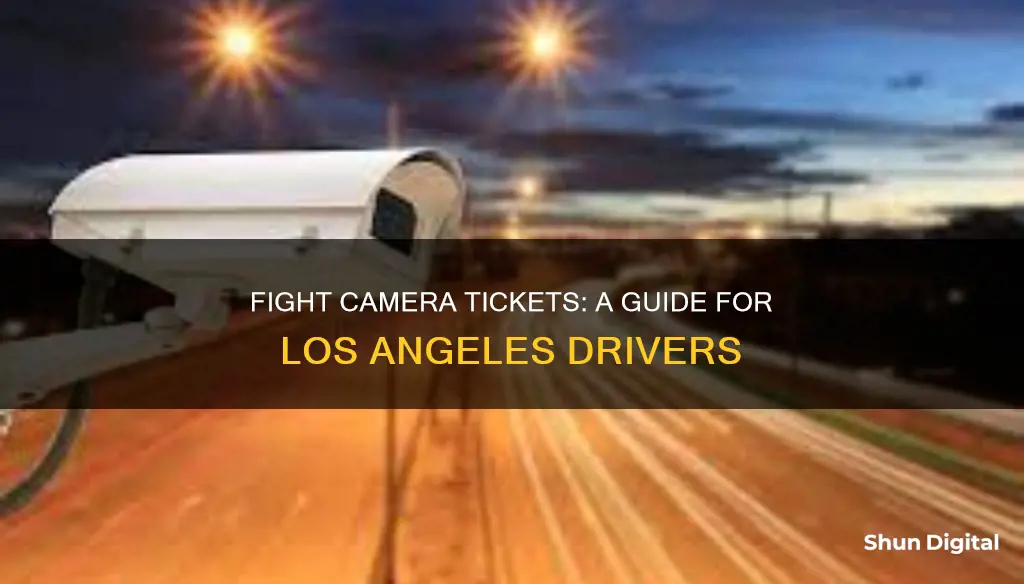
If you've received a red light camera ticket in Los Angeles, you don't necessarily have to pay it. You have a constitutional right to plead your innocence and fight the ticket. While it may be easier to just pay the fine, there are several ways to build a defence and contest the violation in court.
| Characteristics | Values |
|---|---|
| Ticket price | $490 or more |
| Ways to fight | Blurry photo, camera unreliability, hearsay, emergency situation, preventing a serious accident, yellow light interval, no warning signs, compliance defence |
| Time to receive decision | 2-3 months |
What You'll Learn

Plead not guilty at your arraignment
If you want to fight a camera ticket in Los Angeles, you must plead not guilty if you want to dispute it. Pleading not guilty at your arraignment is the same as requesting a trial. When you do this, the judge will typically set a date for the trial in the future.
You can plead not guilty by mail or online if your jurisdiction allows it. If not, you will have to appear at the arraignment. This may also be called a first appearance or a notice hearing, depending on your jurisdiction.
After pleading not guilty, demand a full formal hearing or trial. You may be required to attend other hearings, such as pre-trial hearings or mediations, but do not accept anything less than a full dismissal of your ticket.
Crafting Camera-Friendly Paper: Secrets of Positive Paper Making
You may want to see also

Request a trial by written declaration
If you want to fight a camera ticket in Los Angeles, you can opt for a trial by written declaration, which allows you to challenge your ticket in writing without going to court. Here's a step-by-step guide on how to request a trial by written declaration:
- Plead Not Guilty: Check your citation for the date and time of your arraignment or pre-trial. At this hearing, you will be expected to enter a plea. To fight your ticket, you must plead "not guilty." Some counties may allow you to enter this plea online, while others require you to appear in court and fill out a form or submit a letter.
- Understand the Process: A trial by written declaration involves submitting a written statement and evidence to support your case. The judge will review your statement, along with any evidence and a statement from the law enforcement officer who issued the ticket, and make a decision. If you are found not guilty or the fine is reduced, the court will refund any money you paid.
- Gather Evidence: Start gathering evidence to build your case. This can include photographs, videos, witness statements, or any other relevant information. For example, if you argue that the yellow light duration was too short, you can time the yellow light at the intersection and compare it to the required minimum duration.
- Fill Out the Necessary Forms: Obtain and fill out the required court forms for a trial by written declaration. The specific forms may vary depending on your location, but typically, you will need to submit a request for a trial by written declaration (Form TR-205) and provide your written statement. If you need more space for your statement, you can use the Attached Declaration form (Form MC-031).
- Submit Your Forms and Evidence: Submit the completed forms, along with any supporting evidence, to the court by the due date. You can usually mail these documents or submit them online, depending on the court's procedures.
- Pay the Fine (Bail): In most cases, you will be required to pay the fine, also known as bail, when you request a trial by written declaration. If you are found not guilty or the fine is reduced, the court will refund this amount.
- Await the Court's Decision: After submitting your forms, evidence, and payment, the court will review your case and make a decision. This process can take anywhere from 30 to 90 days on average. You will receive a letter informing you of the outcome.
- Consider Your Options if Dissatisfied: If you are dissatisfied with the judge's decision after the trial by written declaration, you have the option to request a new trial in court (Trial De Novo). You must make this request within 20 days of receiving the decision letter. At the new trial, you will have the opportunity to present your case in person to a judge.
Remember that each case is unique, and the specific procedures may vary depending on your location and the specifics of your ticket. Always refer to the information provided by the court handling your ticket, as they will have the most accurate and up-to-date instructions.
Charging Your Gear 360: A Quick Guide to Powering Up
You may want to see also

Present your case in court
If you've received a red light camera ticket in Los Angeles, the first thing to remember is not to panic. You have a constitutional right to plead your innocence and fight your ticket in traffic court. Here's a step-by-step guide to presenting your case in court and fighting your ticket:
Step 1: Understand Your Rights:
Explain that as per your constitutional right, you are pleading not guilty and wish to contest the charge in court. It's important to remember that the burden of proof does not rest with you. The prosecutor must prove beyond a reasonable doubt that you are guilty of the traffic violation.
Step 2: Hire an Attorney:
Consider hiring an experienced traffic ticket lawyer who specializes in fighting camera tickets. An attorney can guide you through the legal process, advise you on the best course of action, and represent you in court. They will be familiar with the local traffic court system and the strategies that work best.
Step 3: Gather Evidence:
Work with your attorney to gather persuasive evidence to support your case. This may include obtaining a copy of the photo taken by the camera. If the photo is blurry or unclear, it can be used as evidence to dispute the ticket. Remember that you are under no obligation to answer questions from the authorities or provide information that may incriminate you.
Step 4: Prepare Your Defence:
There are several legal defences you can use to argue your case in court. Here are some strategies to consider:
- Blurry Photo: If the photo doesn't clearly show your face or licence plate, argue that there is no conclusive proof that it was you or your vehicle.
- Camera Reliability: The prosecution must prove that the camera was functioning correctly at the time the photo was taken. Challenge this by requesting the camera manufacturer to testify in court about the camera's condition. If they cannot prove its reliability, their case weakens.
- Emergency Situation: If you ran the red light due to a genuine emergency, such as rushing to a hospital, the judge may consider that you did not intentionally break the law.
- Preventing an Accident: Argue that you ran the red light to prevent a serious traffic accident or a dangerous road situation.
- Hearsay: Under the Sixth Amendment, you can argue that the photo is hearsay and inadmissible as evidence. You have the right to confront your accuser, which is not possible with a photo.
Step 5: Attend Your Court Date:
On your scheduled court date, present your case confidently and provide the evidence and arguments prepared with your attorney. Remember that the prosecutor must prove your guilt, and any reasonable doubt should work in your favour.
Fighting a camera ticket in Los Angeles requires knowledge of your rights, strategic evidence gathering, and a well-prepared defence. By following these steps and working with an experienced attorney, you can effectively present your case in court and increase your chances of a favourable outcome.
Adjusting Midtones in Camera Raw: A Step-by-Step Guide
You may want to see also

Appeal an unfavourable decision
If you receive an unfavourable decision, you can appeal it. Here is what you need to know about the appeal process:
Consult an Attorney
While it isn't necessary to have an attorney, if you still want to fight your ticket, it may be worth it to have one on your side. Your conviction will only be overturned if the judge made a legal error in your case. If you aren't extremely familiar with the law, this can get complicated. Look for an attorney who specialises in traffic law and preferably choose someone who has experience getting red-light ticket convictions overturned.
File a Notice of Appeal
The notice of appeal is a court document you must file to initiate the appeals process. It must be filed no later than 30 days after the judge hands down the decision in your case. If you miss this deadline, you lose your right to appeal. There is no fee to file a notice of appeal. If you are representing yourself or have not yet hired an attorney before the deadline, you can download a form to use on the California Courts website.
Request a Record of the Oral Proceedings
In some situations, the appeals court requires you to send in a record of the oral proceedings of your original trial. There are three forms this can take: an official electronic recording or transcript of the recording, the court reporter’s transcript, or a Statement on Appeal if the trial was not recorded. If you're not sure if you need a record of the oral proceedings, request it to err on the side of caution.
Prepare, File, and Serve Your Statement of Appeal
This court document must be completed and filed with the court within 20 days after you file your notice. It tells the court why you are filing your appeal and how you think the appeals court should rule. File your completed statement with the clerk of the court and have the prosecutor in your case served. If you don’t know the name of the prosecutor, it may be listed on the judge’s decision. Typically, to have the prosecutor served, send a file-stamped copy of your statement using certified mail with a return receipt requested.
Present Your Oral Argument in Court, If Requested
If you've requested oral argument, you must appear in court before the appeals court judge and explain the legal errors that require your conviction to be overturned. Waive oral argument if you prefer, and the judge will make their decision based on the statements you and the prosecutor filed with the court. Make sure the fact that you want to waive oral argument is included in your statement of appeal.
Receive the Appellate Court's Decision
After the date set for oral argument, the judge has 90 days to enter a written decision in your case. This date remains the same regardless of whether you've waived oral argument. If the decision is in your favour, the ticket will be dropped. If it isn’t, be prepared to pay the fine in full. The appeals court clerk will mail you a copy of the written decision when it is entered. You may also be notified by phone.
Charging Camera Batteries: First-Time User Guide
You may want to see also

Hire a lawyer
If you've received a red light camera ticket in Los Angeles, it's a good idea to hire a lawyer to help you fight it. A lawyer specializing in traffic tickets can guide you through the process and improve your chances of a positive outcome. Here are some reasons why hiring a lawyer is a smart move:
Knowledge of the Legal System
Experienced traffic lawyers, such as those at The Ticket Clinic, are well-versed in traffic law and the local traffic court system. They understand the complexities of the criminal court system and can navigate the legal process with ease. This knowledge is invaluable when building a strong defence and challenging the ticket.
Burden of Proof
In the case of a red light camera ticket, the burden of proof lies with the prosecution. They must prove beyond a reasonable doubt that you willingly broke the law. A lawyer can help you assert this right and demonstrate that the prosecution's evidence is insufficient or unreliable.
Challenging the Evidence
There are several ways a lawyer can challenge the evidence presented by the prosecution. They can argue that the photo taken by the camera is too blurry to clearly identify you or your licence plates, creating reasonable doubt about whether it was indeed your vehicle. They can also question the reliability of the camera by demanding proof that it was functioning correctly at the time the photo was taken. If a representative from the camera manufacturer does not appear in court to verify its accuracy, your lawyer can argue that the evidence is unverified.
Legal Defenses
Your lawyer can employ various legal defences to demonstrate your innocence. They can argue that you ran the red light due to a genuine emergency, such as rushing to a hospital, or to prevent a serious traffic accident or a dangerous road situation. These defences can help sway the judge's decision in your favour.
Protecting Your Rights
A lawyer will ensure that your constitutional rights are protected throughout the legal process. They can inform you of your right to plead your innocence and challenge any evidence that violates your rights, such as invoking the sixth amendment to argue that the photo is hearsay and inadmissible.
Convenience and Peace of Mind
Fighting a traffic ticket can be a stressful and time-consuming process. With a lawyer by your side, you can rest assured that your case is in capable hands. In most cases, you won't even need to attend court, as your lawyer will represent you and work towards getting your case dismissed or your fine reduced.
Focus Camera: Tax-Free Shopping?
You may want to see also
Frequently asked questions
First, determine whether you have received a "snitch" ticket or a real ticket. A "snitch" ticket can be ignored, whereas a real ticket cannot. If you have received a real ticket, you can fight it in court or online.
A "snitch" ticket is sent by the police to find out the identity of the driver. It has four photos arranged at the bottom of the page. A real ticket, on the other hand, has four photos arranged in a column on the right side of the page.
There are several defences you can use:
- Blurry photo: If the photo is blurry and does not clearly show you or your license plates, you can argue that there is no clear proof that it was you or your car.
- Camera reliability: The prosecution must prove that the camera was in perfect working condition when the photo was taken.
- Witness at trial: The manufacturer of the camera must testify that it was in perfect condition. If they do not appear in court, you can argue that its accuracy is not verified.
- Hearsay: You can argue that, under the Sixth Amendment, the photo is hearsay and thus inadmissible as evidence.
- Short yellow light interval: California law mandates a minimum time for yellow lights. If the yellow light was unusually short, you can use this as evidence.
- Missing or obscured warning signs: California law requires a warning sign within 200 feet of the intersection. If there are no warning signs or they are not clearly visible, you may have a defence.
If you weren't driving, you can submit an affidavit stating that you were not the driver. You are not required to provide the name of the person driving, but if you do know their name and address, you can provide this information so that the citation can be sent to them.
If you want to fight the ticket, you must enter a plea of "not guilty" at your arraignment. You will then need to organise your documents and evidence for the trial, where you will present your case to the judge.


